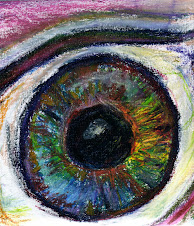A very common learning related visual problem is poor eye movements. The six eye muscles in each eye should work together to point the eye to a visual target such as a word on a page or a baseball coming towards a bat or glove. There are actually two types of eye movements facilitated by these muscles. Pursuits are the movements the eyes make to follow a moving visual target smoothly. When I am helping a patient develop good pursuits, I often characterize this skill as "ice skating for your eyes." The other type of eye movement is called saccades. Saccades are the short hops the eyes make between two fixed visual targets such as when going from the end of one line of text to the beginning of the next line.
Both pursuits and saccades are developmental eye movements. Like learning to swim or ride a bicycle, once a person knows how to do them, they continue to improve. With experience, the person can coordinate the movement automatically and fluently enough to do other things at the same time like carry on a conversation, for example. However, for patients whose developmental eye movements are delayed, basic tasks like reading, lining up digits in a math problem, or hitting a baseball can be very difficult.
There is a simple test that optometrists use to test a child's eye movements called the Developmental Eye Movement Test (DEM). It is available exclusively from the Bernell company (www.bernell.com). Bernell provides an assortment of tools for optometrists and vision therapists. The DEM can be used for children as young as first grade. First the child is asked to read a column of 80 single-digit numbers arranged vertically. The examiner times the child with a stop watch. Then the child must read the same 80 numbers arranged in rows horizontally with random gaps in the rows. By the time a child is twelve years old, the speed with which they read the vertical numbers should match their speed reading the horizontal numbers. The test has been validated over a period of years so norms for a child's performance scores have been established according to both age and grade. Besides comparing the vertical and horizontal reading speeds, the DEM also measures the number of errors made by the child. It only takes about three minutes to complete the entire DEM but the results may explain why a child is having difficulty in school in spite of having 20-20 vision.
If your child scores poorly on the DEM, vision therapy may be indicated. Your child may also be helped by the activities in the
Purple Book of the
Eye Can Too! Read Series. While I wrote the series for home-schooling families, anyone can implement the activities which are similar to what we use in in-office vision therapy to address eye movement deficits.




